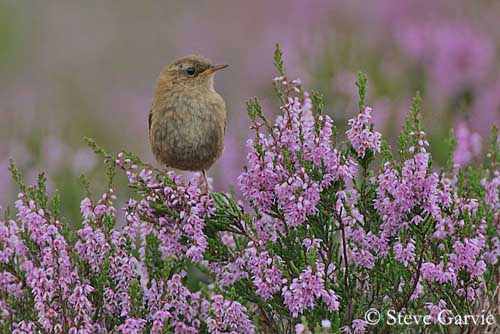
Text by Nicole Bouglouan
Photographers :
Marc Chrétien
MURINUS
Maxime Dechelle
LEPAPARRAZO
Steve Garvie
RAINBIRDER Photo galleries
Tom Grey
Tom Grey's Bird Pictures
Patrick Ingremeau
TAMANDUA
Eduardo Andrés Jordan
MIS AVES - AVES DE ARGENTINA
René Lortie
http://rlortie.ca/
Eugène Montocchio
Galerie Photos Nature
Bob Moul
Nature Photography
Jean Marc Rabby
Des Ailes et des Plumes
Philippe Wolfer
OISEAUX D’ARGENTINE
Nicole Bouglouan
PHOTOGRAPHIC RAMBLE
Sources :
HANDBOOK OF THE BIRDS OF THE WORLD Vol 10 by Josep del Hoyo-Andrew Elliott-David Christie - Lynx Edicions - ISBN: 8487334725
WRENS, DIPPERS AND THRASHERS by Brewer David – illustrated by Barry Kent Mackay- Yale University Press - ISBN: 0300090595
CREAGUS@Monterey Bay (Don Roberson)
Wikipedia (Wikipedia, The Free Encyclopedia)
FAMILY TROGLODYTIDAE
Within the huge order Passeriformes, the family Troglodytidae includes small insectivore birds. They are New World species except the Eurasian Wren (Troglodytes troglodytes) which also occurs in the Old World.
Often mentioned in Old World’s legends and less extensively in New World mythology, this lovely bird is a symbol of a natural environment that must be protected.

Troglodytes troglodytes
Troglodytids are small birds, except the Giant Wren (Campylorhynchus chiapensis) of Southern Mexico with a length of 22 centimetres. The smallest is the Sedge Wren (Cistothorus platensis) with a length of 10 centimetres.
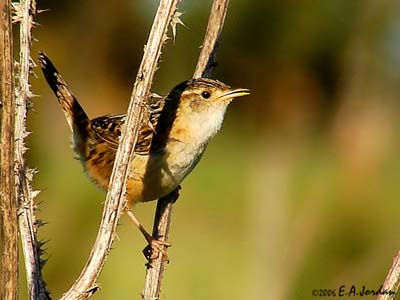
Cistothorus platensis
They usually have dark plumage with brown, black or rufous colours, sometimes with black and white pattern or areas.
Some birds in the genus Thryothorus may show beautiful patterns on head and chest.
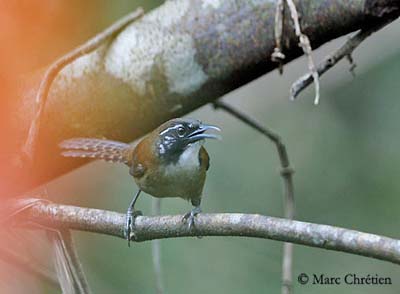
Coraya Wren
Thryothorus coraya
A typical feature of almost all wrens is the predominance of barring both on flight and tail feathers. The size of the tail varies according to each species. Wings are relatively short and rounded, allowing short flights into the dense vegetation.
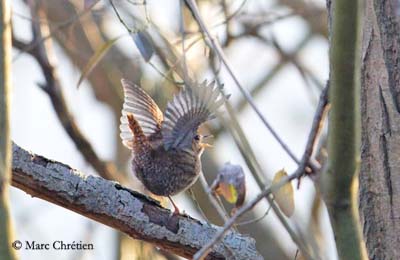
Troglodytes troglodytes
Wrens do not show sexual dimorphism in plumage. Male and female are similar and there is usually little difference between young and adults.
The bill is often relatively long and slightly down-curved, and depends on lifestyle and feeding behaviour according to the species.
Wrens spend most of their time foraging in low vegetation near the ground. These birds usually have heavy and powerful legs and feet with long claws.
But the birds of the genus Odontorchilus which forage in canopy have fine and dainty legs and feet.
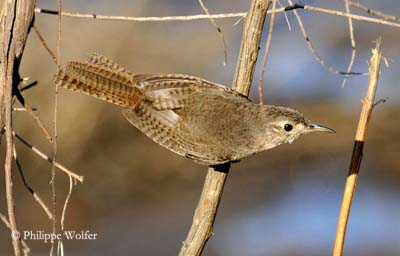
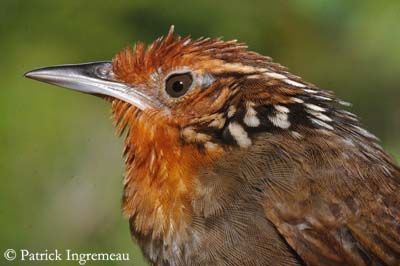
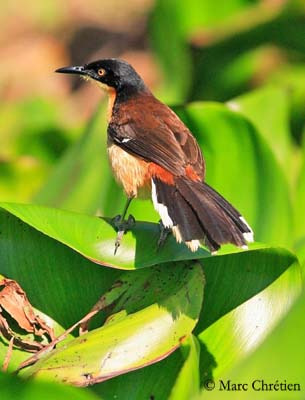
One species was recently included in Troglodytidae, in spite of its external appearance closer to Mimidae than wrens. The Black-capped Donacobius (Donacobius atricapilla) has powerful rounded wings and long, graduated, almost fan-shaped tail. Legs are long and robust, bill is long and sturdy. This bird has a patch of orange or yellow bare skin on the neck sides, used during displays.
Donacobius atricapilla
Troglodytidae usually are good singers. The songs range from whispers to loud sounds. Here there are some examples such as the Canyon Wren uttering cascading, sweet, liquid whistles, the Cactus Wren giving rhythmic “char-char-char-char” in the desert, the Marsh Wren and its unmistakable gurgling, the Carolina Wren and its melodious “teakettle-tea-kettle”, and the Thryothorus wrens and their striking songs and duets.
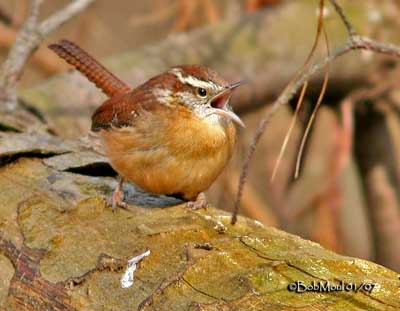
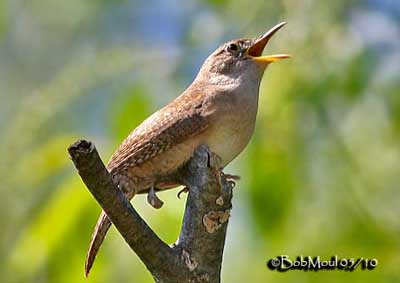
The young birds learn the songs from their parents by imitating them. They usually become good singers by the following spring and are able to establish their own territory.
Vocal dialects may vary over short geographical distances. They usually sing by day, except the Marsh Wren which sings at night, especially in moonlight.
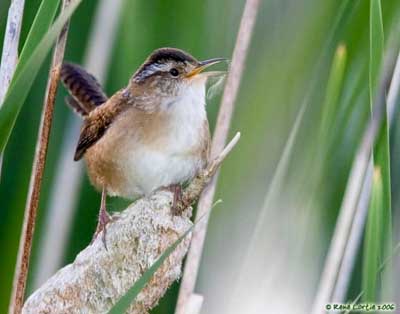
Marsh Wren
Cistothorus palustris
Wrens have adapted to a very wide range of habitats. They require areas of trees with undergrowth, and usually prefer humid habitats whereas some species such as the Happy Wren (Thryothorus felix) and the Banded Wren (Thryothorus pleurostictus) are found in drier forest and bushland. But most of Thryothorus often live at forest edge.
On the other hand, the birds of the genus Microcerculus are highly territorial and live in restricted to undisturbed virgin lowland humid forest. They are found at low altitude, except the Flutist Wren (Microcerculus ustulatus) which is a montane species visible from sea-level up to 2100 metres of elevation in Venezuela.
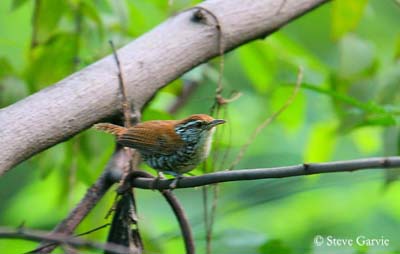
Banded Wren
Thryothorus pleurostictus
Some troglodytids such as the Canyon Wren are associated with rocky areas, living in dry to arid regions in boulders and slopes, also on rock faces, canyons and sea-cliffs in California. They are visible in cool uplands at up to 3000 metres of elevation.
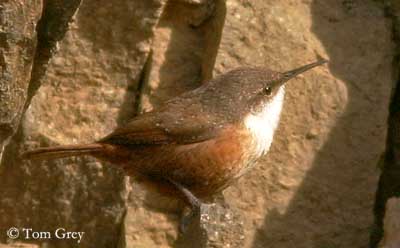
Catherpes mexicanus
The Cistothorus species prefer the wet habitats of varying types. The Marsh Wren is confined to vegetation over standing waters such as cat-tails and reeds, or sedge in brackish coastal marshes.
The Black-capped Donacobius is another wetland-dwelling. It frequents brushy vegetation along riversides and nests only in marshy vegetation.
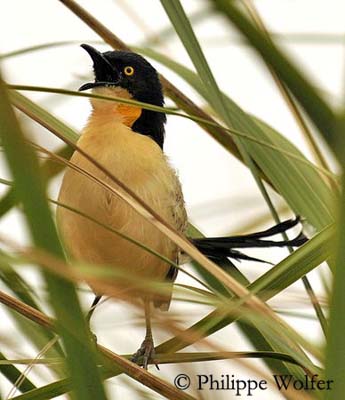
Donacobius atricapilla
The Eurasian Wren occurs in four continents, North America, Europe, North Africa and Asia where it frequents several types of habitats from sea-level in Europe, up to 1200-1800 metres in North Africa, and up to 2500 to 4800 metres in Nepal.
These small birds have been successful in adapting to various types of habitats at different elevations according to the range.
Wrens are mainly a New World family, and range in the Americas (from Alaska and Canada to S Argentina). Only one species, the Eurasian Wren, is also found in Europe, Asia and North Africa.
The species living in Central and South America are resident, whereas other populations migrate to warmer areas in winter.
The young birds disperse after leaving the family group, but the distances often are very short.
In the Old World, the Eurasian Wren includes sedentary and migratory populations with northern birds travelling southwards in winter.
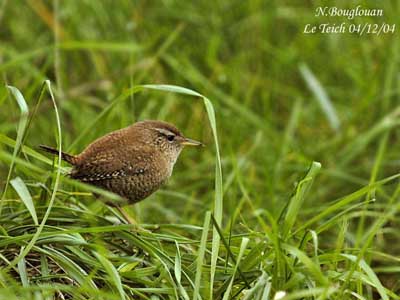
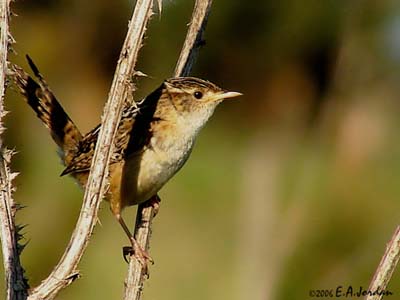
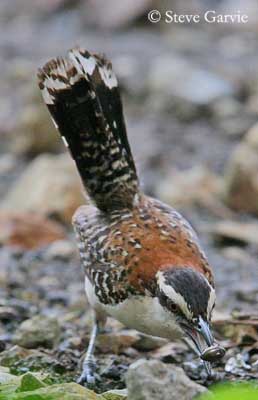
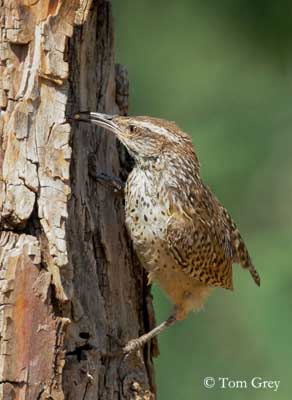
Wrens feed primarily on Arthropods, but the techniques vary according to the species. Their feeding behaviour depends on the habitat. Most of them forage in the lower vegetation, examining leaves for preys, or searching in the leaf litter. They take several types of insects such as lepidopteran larvae, ants, bugs, grasshoppers, flies, but also spiders, woodlice, centipedes and millipedes. They feed on some seeds but very little.
Campylorhynchus rufinucha
Campylorhynchus brunneicapillus
The Carolina Wren is the only one taking small invertebrates such as lizards, tree-frogs and even young snakes.
The Black-capped Donacobius feeds almost exclusively on invertebrates taken from leaves or in flight.
Both members of the genus Odontorchilus feed in the upper level of forest, up to 30 metres above the ground. Some terrestrial wrens follow the swarms of army-ants.
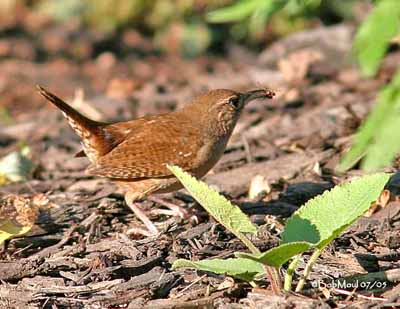
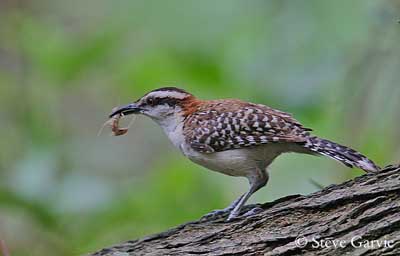
Rufous-naped Wren - Campylorhynchus rufinucha
The Eurasian Wren is somewhat different and may take tadpoles and tiny fish, wading into shallow water and even immersing the head.
The rock-dwelling wrens such as the Rock Wren and the Canyon Wren have longer, down-curved bill which allows them to forage deeply into rock crevices.
Troglodytids are opportunistic, taking advantage of any available food source.
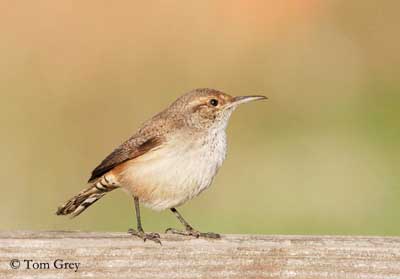
Salpinctes obsoletus
Wrens are furtive and secretive birds, very difficult to see. They disappear into the dense vegetation if disturbed. In temperate climates, they often are solitary or in pairs, living in family groups during a limited period after the nesting season.
Often wrens are more gregarious and occur in flocks or join mixed flocks. Many wrens roost in family groups or female remains with young. The Eurasian Wren may use communal roosting-sites.
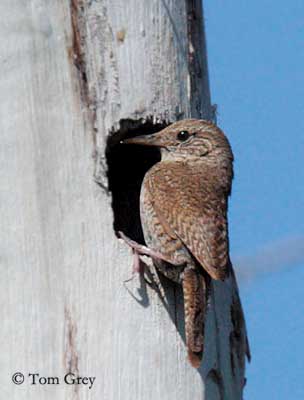
Many wrens of different genera and habitats have developed a strange behaviour. They destroy the eggs and sometimes the young of other bird’s species. The Northern House Wren (Troglodytes aedon) is very destructive. It enters the nest of other species such as Carolina Chickadee, Tufted Titmouse or White-breasted Nuthatch, and pierces the eggs or removes them.
This type of behaviour has been observed for more than a century, giving this bird bad reputation. In some regions, the predation by the wrens plays an important role in Warbler’s declines.
Northern House Wren
Troglodytes aedon
The Black-capped Donacobius behaviour is similar to those of mockingbirds. It is a noisy bird, occurring in small family groups. This species performs ritualized mutual displays (see the card of this bird).
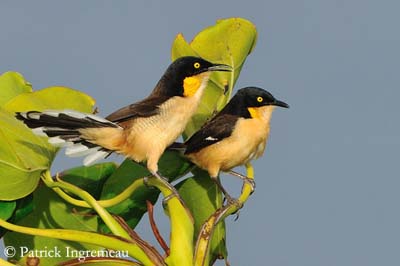
Donacobius atricapilla
Wrens perform water-bathing and dust-bathing, according to the range. Some others also perform sun-bathing.
They can be aggressive in territoriality and breeding. During the threat displays, the bird spreads the wings, the tail is partially fanned and drooped, whereas the bill is pointed at the intruder. Physical combat is rare.
Both birds fly upwards over short distance with flapping wing-beats into each other, grasping their feet and pecking.
When they are excited, wrens often cock the tail nervously.
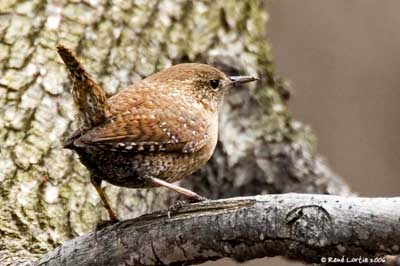
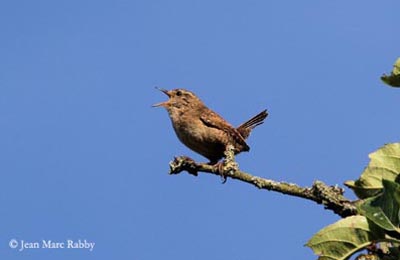
Wrens have some features and strategies unusual in passerines, including polygamy, occasionally polyandry, and also co-operative breeding.
They build several nests in a single season, more or less according to the genera. The Marsh Wren may build up to 22 different nests, and the female chooses the most suitable and she completes it, or the male does it for her. The surplus of nests are used to confuse the predators and for roosting.
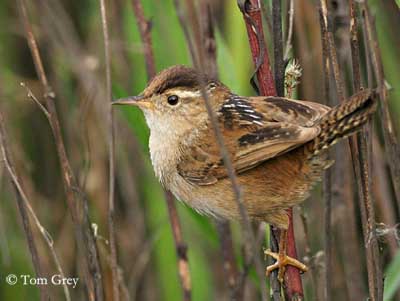
Marsh Wren
Cistothorus palustris
Members of the genus Campylorhynchus are co-operative breeders, with helpers which take part in the territorial defence, rearing of the young and protection and defence against predators. Some breeding groups can contain up to 14 birds with a dominant breeding pair and several helpers.
Young may remain in their family group for up to one year, and then, females and most of males disperse to other groups.
Except the cavity-nesting species, and the atypical Black-capped Donacobius, all the wrens build a nest with a roof and a side-entrance. The nest is an ovoid ball of grass, rootlets and fibres with a hole at the side. The interior is lined with finer materials.
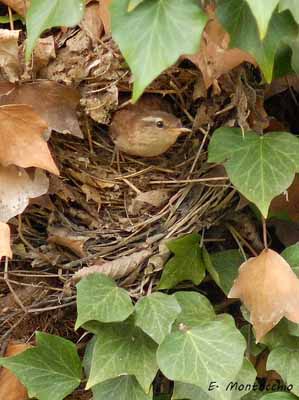
Troglodytes troglodytes
The Marsh Wren’s breeding nest shows a sill at the entrance to avoid the eggs to fall in windy conditions.
The nest-shapes vary between the species. Some of them have two parts with a nest-chamber and an entrance tunnel.
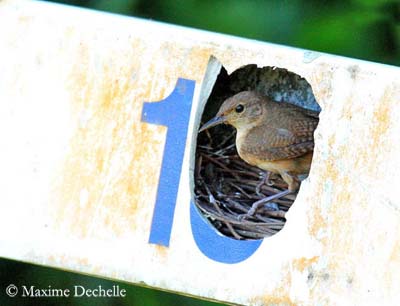
Northern House Wren
Troglodytes aedon
The crevice-nesting species build open structures with dead leaves and without roof. The Canyon Wren builds an open cup with fine materials on a base of twigs and moss, whereas the Rock Wren builds a nest-foundation with pebbles.
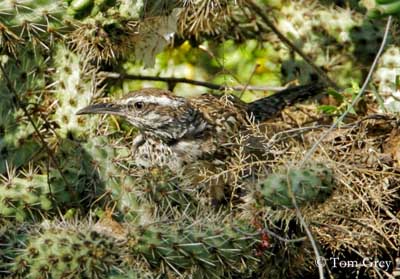
Campylorhynchus brunneicapillus
Wrens nest in vegetation of all kinds, dense brush, grasses, rushes, cacti, natural cavities or nest-boxes, rock crevices and even abandoned burrows in sandy banks in the genera Microcerculus.
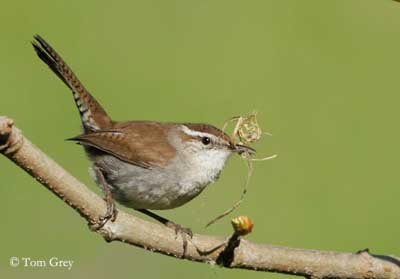
Thryomanes bewickii
Clutches vary from 2-3 to 5-7 eggs, according to the range. The birds of the tropical regions lay smaller clutches than in temperate ones. They usually produce several broods per season.
Incubation is usually by female alone, and sometimes the male feeds her at nest. This period lasts from 12 days (Rock and Canyon Wrens), to up to 23 days (Cactus Wren), usually 18-20 days in most species.
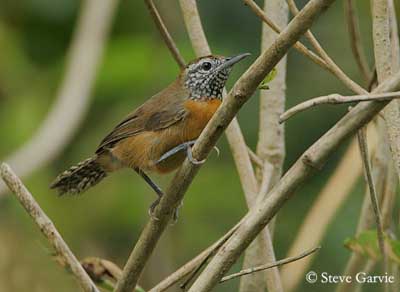
Rufous-breasted Wren
Thryothorus rutilus
The Brown-headed Cowbird and the Shiny Cowbird may parasitize the wrens’ nests, involving nest failures.
In South America, the Striped Cuckoo (Tapera naevia) and in Europe the Common Cuckoo (Cuculus canorus) also are nest-parasites.
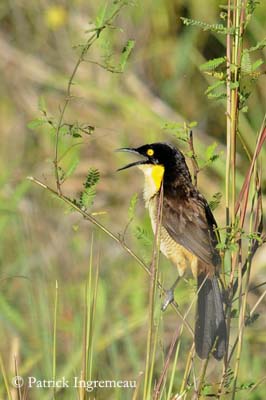
The Black-capped Donacobius is also co-operative nester when it occurs in high density. It builds an open cup in vegetation, often over water or at the edge. The clutch of 2-3 eggs is incubated by female alone during 16-18 days. It usually produces only one brood.
Donacobius atricapilla
Numerous wrens’ species have large range but their habitat is fragmented and degraded. Natural deaths from starvation during harsh weather conditions are serious threats for the populations during the following years. But fortunately, wrens are usually able to recover good numbers within a short period.
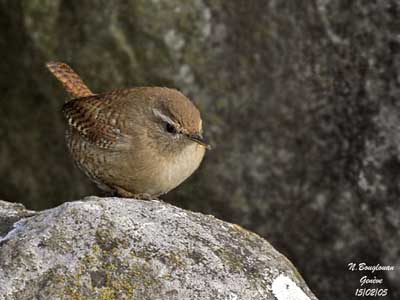
Troglodytes troglodytes